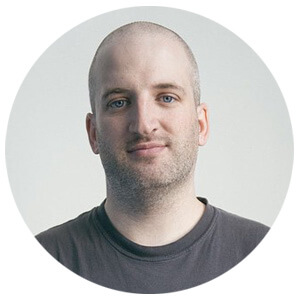
Nick Leadlay is a Los Angeles-based fashion, entertainment and advertising photo retoucher who has worked with pretty much every magazine and in-demand brand you care to name, including Vogue USA, Vanity Fair, Elle USA, Canon, Comcast, and ESPN.
MASV sat down with Nick to get the inside dope on why he loves refining and fine-tuning images for final presentation, his workflows, his preferred tools, and how he got into the professional retouching game in the first place.
Jump to section:
- How did you get into the photo retoucher business?
- What exactly is a photo retoucher?
- Describe your retouching style and how it differs from others?
- How does one become a photo retoucher?
- Is it common for people to specialize in retouching?
- What kind of clients typically hire a photo retoucher?
- Where does a photo retoucher fit into the overall production workflow?
- Who do you talk to the most on your job?
- What tools are required for the job?
- Do you work a lot with the print side of things?
- Can you describe the workflow of an on-set digital tech?
- Where do you find creative inspiration?
- How do you see the role evolving with cloud tech and better mobile cameras?
Send Hi-Res Photos and Videos With MASV
Easy and quick file transfer for large media
How did you get into the photo retoucher business?
I always had an interest in photography. When I was a kid one of my favorite things to do was go through all the old photos in shoeboxes and sort them, as kind of a very early version of what I do now. My dad always had a nice camera so I played around with that.
During the explosion of the internet, computers, and digital images in the 90s, I learned some Photoshop and video editing. My brother actually had a really early version of Photoshop, and I remember he was at a computer and he was like, “Hey, look what I did to this photo of you” – and he had removed my friend’s leg. And my brain just exploded. It was amazing. This was even before digital cameras. I think he had scanned a hard copy of the photo.
And I also got some hands-on Photoshop training in college. So that was always in the back of my mind, but then fast forward to around 2010 when I rolled my ankle playing soccer. I was just sitting on a couch and started watching photography videos and Photoshop tutorials. And I really just got obsessed with that, and just got really into that whole world.
I eventually started retouching some people’s photos just for free. And then started getting paid a little bit, and built up a little portfolio. And before I knew it, I started making money retouching other people’s photos. And I was like, ‘crazy.’ Like, this is cool. I liked it, you know? It was fun. And within a year or so I was making all my money as a photo retoucher, and making no money shooting.

See more of Nick’s portfolio
But I should also point out that I do two jobs within the realm of photography, and it’s a pretty even split, actually. My other career is more of an on-set digital tech role. So I’m overseeing the building of all the cameras, and I’m the photographer’s eyes and ears in the sense that they attach their camera to my computer and the photos, as they take them, come into my computer. So I manage the images, check focus as the photographer is shooting, back the files up, and prepare drives for the client. It’s mostly a data management role, but there are also visual checks and balances.
Read More: Digital Imaging Technician (DIT): The Unsung On-Set Heroes
What exactly is a photo retoucher?
I like to think of it as taking off those sharp edges, and just kind of helping the subject of the photo out. But the trickiest part is doing it. A well retouched photo doesn’t look retouched. You don’t know that I went in, did it, and got out. It’s like being a pixel ninja, as we used to say – you get in, you fix it, you get out, no one’s the wiser. That, to me, is a good touch.
Retouching is especially necessary now because any photo that comes out of a digital camera is RAW. It’s in an intentionally neutral state so that it can have something done to it in post production, to take it to any place you want. That’s unlike the old days where the film you used kind of defined your look. Now it’s intentionally RAW, so that you can take it in any direction you want.
So a big part of being a photo retoucher is creating a color look, and contrast, and a color grade. And then beyond that obviously is cleaning up people’s complexions and other details.
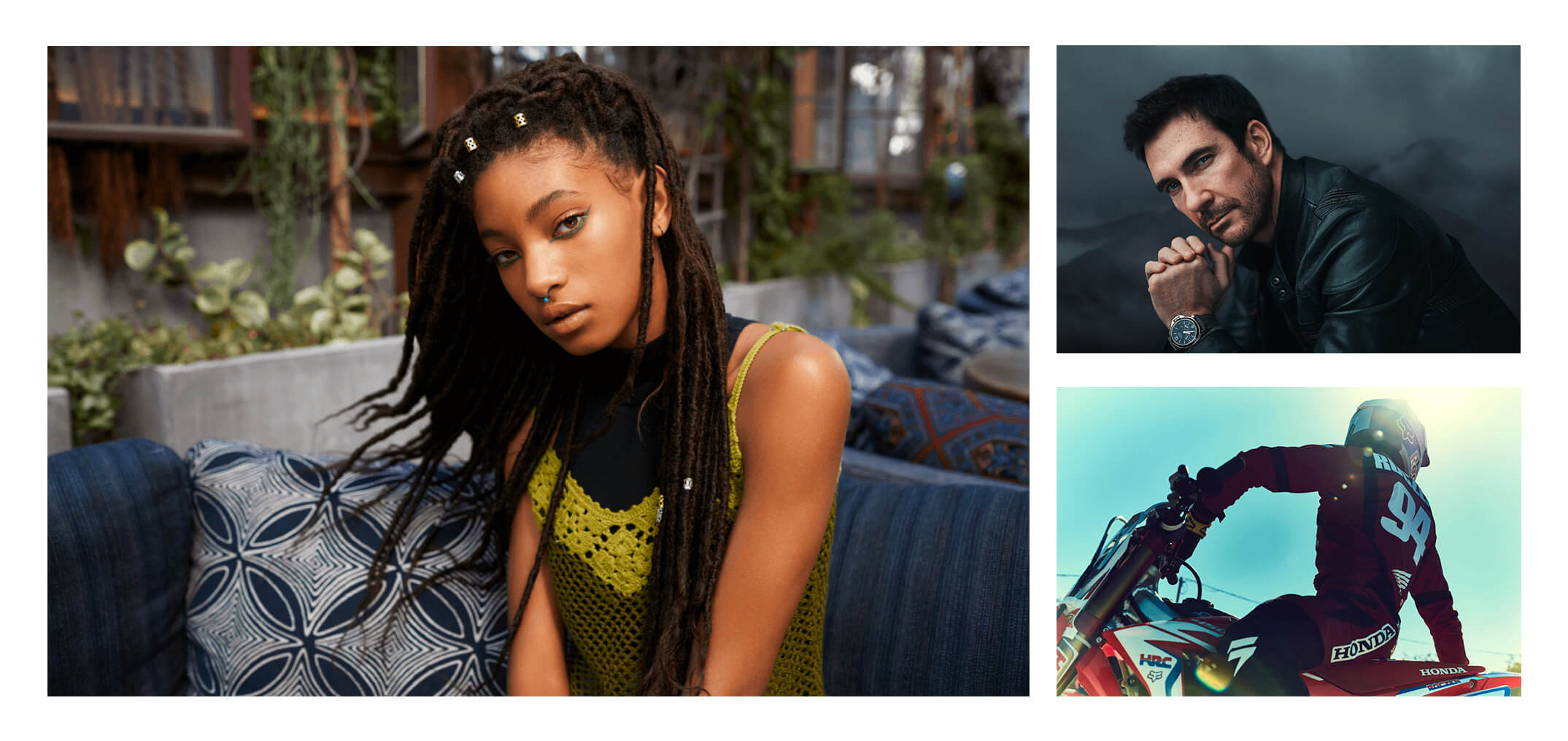
Describe your retouching style and how it differs from others?
Retouching is something that in the media maybe is portrayed negatively, and rightfully so sometimes, because it did go too far at one point.
I was never really a big fan of the super overly retouched stuff. I was always drawn to a more natural look. And it’s actually something that was a big part of my early success in the field, to be honest, because 10 years ago, especially in fashion, it was a very overly processed kind of plasticky skin look. I didn’t like that. I went for a more natural look. And it’s something that’s gotten me hired a lot, because now the trends have changed away from overly retouched stuff and towards a more natural look.
And now it’s to the point where I’ve done campaigns in the last year where people are literally saying, “Don’t touch the skin. Like, don’t do it.”
How does one become a photo retoucher?
I don’t definitively know the answer. Obviously there are Photoshop classes at universities and colleges, but I don’t know of any formal education in the sense of a two-year program or something like that. Maybe it exists. But not that I’m aware of.
Beyond that, there are tons of online tutorials. I think the best way is learning from an established person who has a video series. I have friends, like Pratik Naik, who are really good photo retouchers doing video-based teaching and they’ve fallen in love with it. But definitely make sure you know who’s teaching you. There are a lot of people out there teaching who don’t have the credentials to back it up.
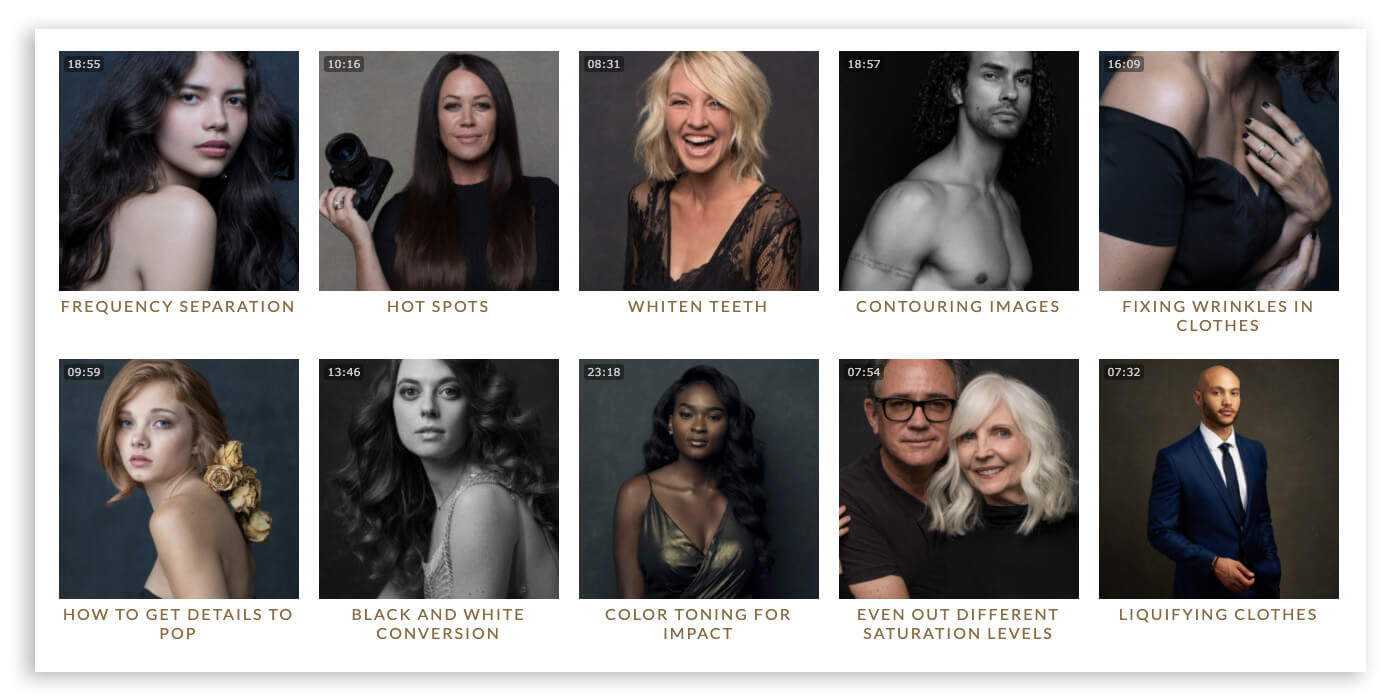
Courses available via The Portrait Masters
Is it common for people to specialize in retouching?
I know a handful of other retouchers who have come up through the years together, or from social media. But otherwise, I don’t know – it’s such an underground thing that’s not really talked about. There could be 10,000, or there could be five.
Part of that is the nature of retouching. It’s hard to even prove I exist, really. I’m the guy who comes in and cleans up and gets out without any credit. You’ll never see my name credited on anything.
Note: Many individual freelancers offer photo retoucher services on on-demand websites like Upwork and Fiverr.
What kind of clients typically hire a photo retoucher?
When I began working professionally I started out mostly in fashion – so I was doing a lot of beauty stuff and fashion editorial, like fashion magazines, covers, photo series, stuff like that.
My first five years were pretty much all in that world, which led to me building a pretty good book of work. Then I began getting more into the commercial world where I started working on bigger commercial projects, like advertisements for airlines, banks, and other large companies.
Soon after that I got more into entertainment – editorial stuff for actors and actresses. And then from that into movie posters, TV shows, and more ad work, which is a lot of where I’m at now. A lot of it doesn’t get shared because it’s not that exciting. The big thing with photography is that people share the cool stuff, but 90 percent of their shoots you don’t know they did, because it’s boring. Don’t tell anyone. [laughs]
The last couple years I’ve gotten more into car retouching and more car shoots, just because I like it. And it was just another revenue stream. I was kind of burning out a little bit after doing up to 10 years of fashion and skin work, and it’s nice to have some projects in different spaces. A car doesn’t have skin, it doesn’t wear clothes – it’s just a different world.
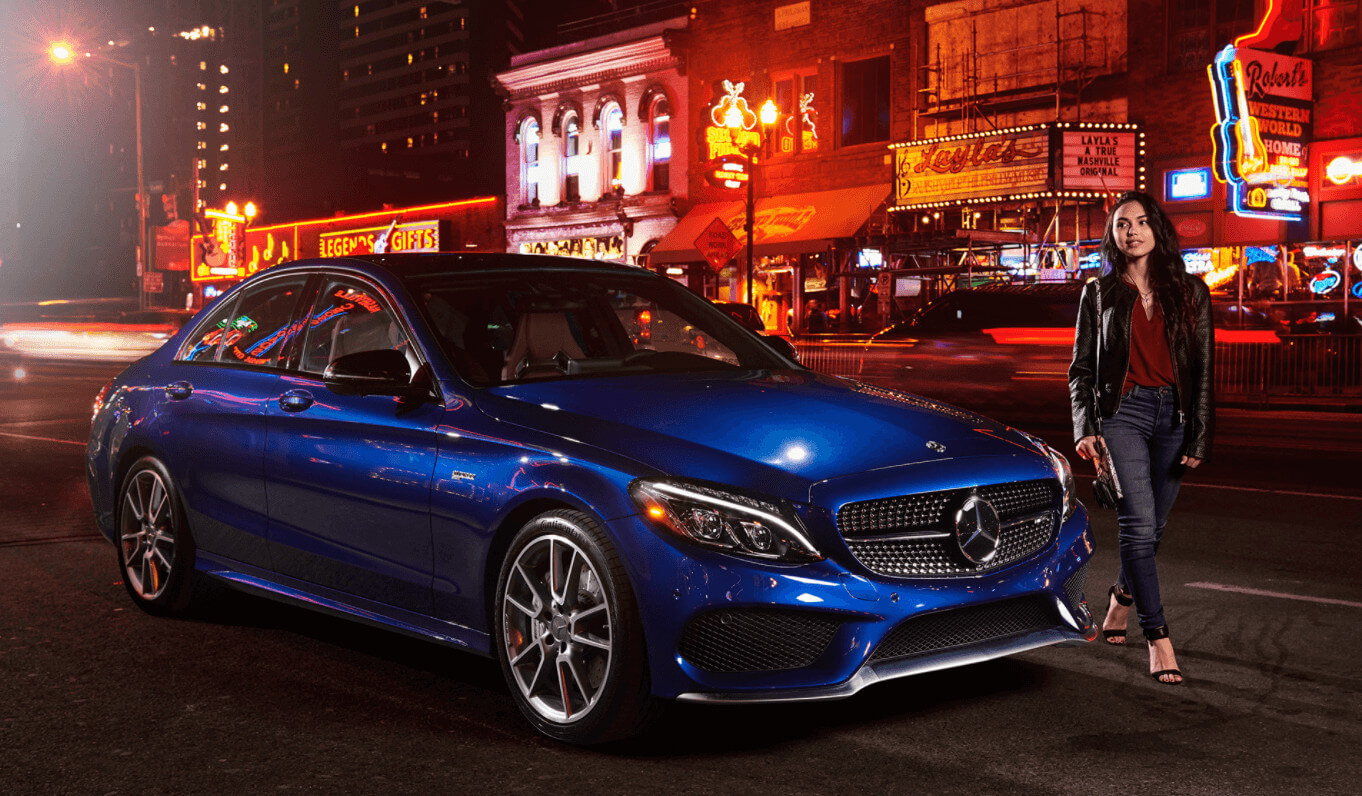
Where does a photo retouch fit into the overall production workflow (pre, principal, and post)?
After doing this for more than 10 years, 90 percent of the time it’s right at the end of the process. It has changed a little bit over the last couple of years as I’ve gotten more established into the bigger commercial stuff.
For a lot of the smaller stuff, though – because a lot of my clients are my friends, in that they’re photographers I work with and we’ve become friends – it’s shockingly casual. Not a lot of contracts. Very laid back. So in that sense, yes, very much at the end. Someone calls me and says ‘Hey, I shot this client, it was a bad day, are you available? Can you do it?’
But with the bigger ad stuff, it’s not that crazy for me to be loosely involved before shooting in that they’ll have me come on a pre-production call. Which is always one of those things where I jump in, and I just kind of sit on it for an hour and say nothing and then leave. It’s kind of like, ‘What am I doing there?’ Maybe there will be one question.
So that’s about the extent of my involvement on the pre end. But traditionally it’s at the end of the workflow and I’m very much the last person in the workflow.
Who do you talk to the most on your job?
On the big stuff it’s usually a producer, for sure. One of two producers, if not both. There are usually two producers on a job like that – the local producer in charge of hiring the crew, and then the agency producer who organizes the shoot. I will usually be connected with both the local producer and agency side producer on the big jobs.
And the photographer will jump in sometimes, because obviously they’re an important part of it. But other times, photographers just end a shoot, pass it off, say, ‘Have fun’ and they’re gone.
What tools are required for photo retouchers?
I live in the Mac world. It’s mostly Mac and Apple products, and I don’t think that’ll be a surprise to anyone on the creative side. We also use Wacom tablets.
Learn More: MASV’s exclusive offer for Wacom Intuos Pro users
As far as software, it’s pretty simple: Photoshop being at the end of the workflow, and then as far as both on-set and off-set preparation of the first wave of management and edits, it’s Capture One Pro. It’s a raw processor and organizer of files – most people call it a more professional version of Adobe Lightroom. It’s the industry standard for my other job, the digital tech job. So that’s really the first step. And then you select in Capture One Pro which images you want to retouch and pass over to Photoshop.
In terms of file transfer, back in the day it used to be a lot of hard drive stuff. Nowadays most people use some kind of file transfer software, but it does depend on the type of job you’re doing. If it’s a simple portrait, maybe eight or 10 images, it’s easy to use Dropbox or WeTransfer.
For more complex, heavier jobs with people and other things in the background, though, I need access to all the files. Sometimes we ‘shop things out of the background that we don’t like. But if they just send me the selects, I don’t have stuff to pull from to replace things in the background. In those cases, because people don’t send hard drives much anymore, I’ll ask them to send me the link to the entire gallery of JPEGs. I’ll then go through those and find the elements I need and ask for that.
But in an ideal world it would be beautiful if I didn’t have to do that. If they could just send the link to all the RAWs in one place that I could access, and I didn’t have to wait for them to see my email, and all that. Because by that point I’ve lost a day.
Get Files Delivered to One Place with MASV Portals
Collect files from multiple parties with a single Portal share link.
Do you work a lot with the print side of things?
Yes, definitely. In those cases they’ll send me the RAW files of the 10 selects or however many we’re going to retouch, along with a PDF of notes, which is where they’ve drawn instructions over the images – you know, like “get rid of this banana cat toy that I see in your background there.” So I’ll have to retouch out the banana cat toy. The client might circle that yellow banana, or ask to darken the windows if they’re a little blown out, that kind of thing. It all gets marked up in the PDF – all 10 photos with their hand-drawn notes.
So I’ll go in and do all that stuff and then export as full-res JPEGs. They’ll have a look and send more feedback, which rarely goes beyond two or three rounds. Then I’ll export the high-resolution TIFFs.
Can you describe the workflow of an on-set digital tech?
There’s not a lot from the photo retoucher world that goes into my digital tech work, other than sometimes I’ll have to do some quick on-set mockups or something. But beyond that there isn’t much other than my eye and knowledge of post-production, which can be a big plus for photographers in that I know what’s needed later for the retouching stage. I can say things like “It’ll be easier in the end if we do it this way”. And I think that’s a big reason why photographers hire me. You can save a lot of money if you make good decisions early in the process.
As a digital tech I’m basically the photographer’s eyes and ears. A lot of times when they’re shooting on-set, the images don’t even come up on the photographer’s screen – they just go straight to the computer and onto my monitor. Once the lighting and focus has been established most photographers just shoot without checking the images. They’re typically relying on me to tell them to stop if something’s gone out of focus or if the horizon is crooked.
This allows the photographer to totally focus on creativity and their interactions with the talent. Most photographers are 100 percent focused on interaction, because you only have a finite amount of time before the talent mentally checks out.
So that’s the main role. Other than that, it’s just making sure everything’s working, the photos are coming in, and look good. Usually, the photographer and I will work on a color grade early, during testing. So before the talent gets there, we’ll dial in a color and then Capture One will apply that color to each frame as it comes in.
Beyond that, I’m also in charge of building the camera: assembling everything, checking lenses, cleaning everything, and making sure that side is good. Plus, maintaining the connection with the cable, because cables die and computers crash. It’s technology. Things happen, so you have to be able to troubleshoot quickly.
And then of course with Covid clients weren’t flying to the set anymore, and some of the crew is remote, so you need to set up monitors for everyone so they can be on a Zoom call. And then we’re doing remote screen sharing, because we’re shooting Oprah’s house and Oprah doesn’t have WiFi for you to use. So you’re in the middle of a field and a horse barn and you need to set up an LTE hotspot modem with a huge antenna. And all of this falls on me for some reason. Covid really was an eye-opener in that way, but it was great because I like learning stuff. I literally added ‘network tech’ to my toolbox of things that I do.
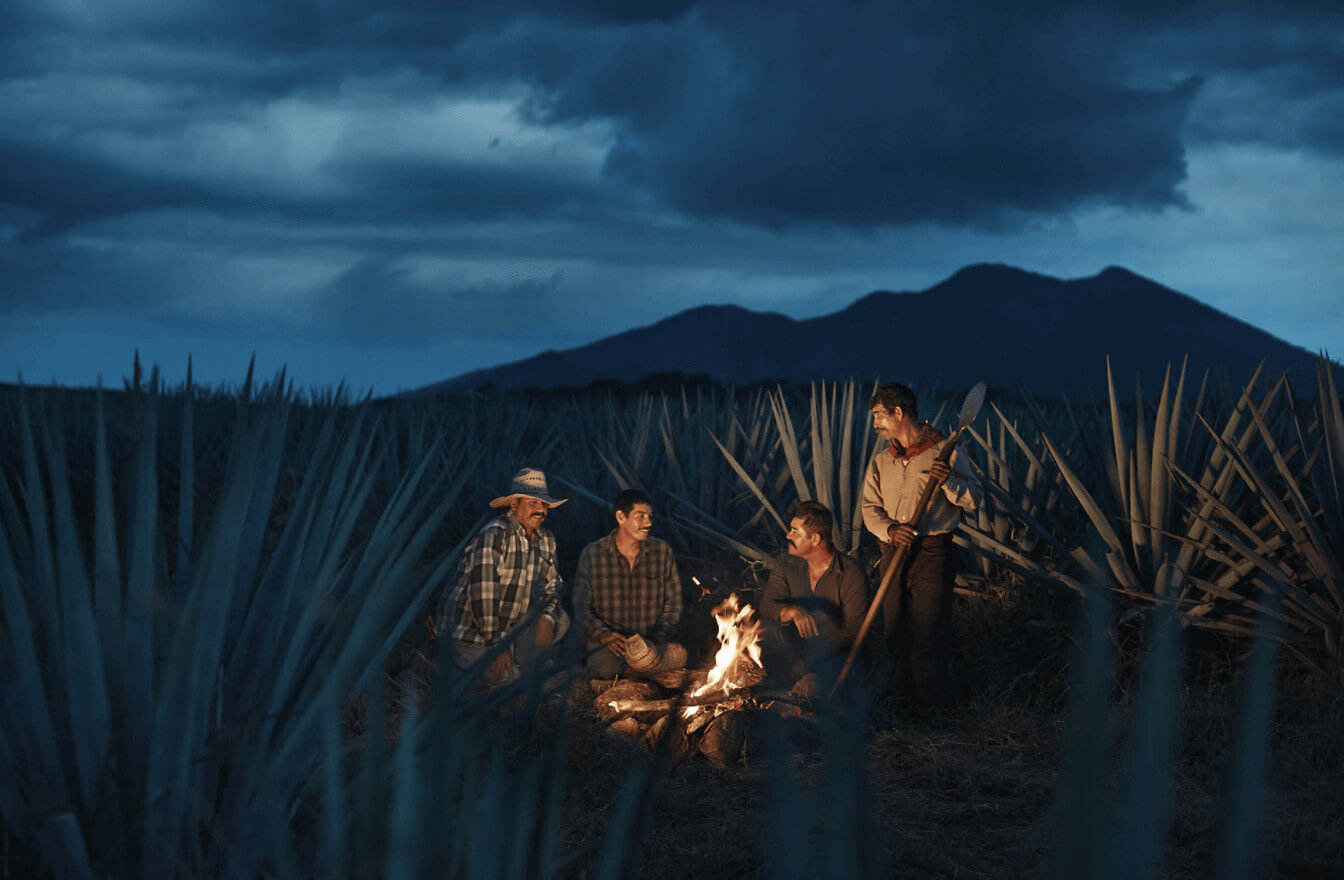
Where do you find creative inspiration?
It’s funny because I could do more work if I could just completely unplug and not care at all about what I’m working on. But I’m not able to do that. I really struggle working on things that I don’t like, to the point that I’ll usually turn it down. Or maybe subcontract it.
Of course it wasn’t like that early in my career – back then I would do whatever. But as you build your career, you don’t need to do that as much and you get to be more selective. So, for me, at this point, I’m very selective. I have to like the work. If I don’t like it at all, and I think it’s not good photography, I really struggle with it.
But one of the things I like about having these two careers, of retouching and on-set digital tech, is that they sort of feed each other. I’m naturally pretty introverted, so retouching works great for that because it’s something I can do sitting alone. But I’m also a social introvert in that after a week of sitting at home I need to get the hell out and hang out with some people. So that’s great, because I can go on-set and joke around with my friends.
How do you see the role evolving with cloud tech and better mobile cameras?
I’ll touch on the mobile one first. Especially living in Los Angeles. I don’t even want to say the word, but we all know it’s coming – the life of the influencer. It’s a thing. We walk around L.A. every day; I go through my little walk and there’s someone doing something stupid and their friend is shooting it. It’s everywhere, right? It’s a real thing.
And in major campaigns now we have to shoot for Instagram, because this influencer is gonna post this wherever. It’s to a point where sometimes professional photographers with $16,000 cameras have to put that down and grab an iPhone and take a shot. And that’s mind-blowing, but it’s a real thing.
So mobile photography is unavoidable, and I’ve had to retouch that stuff, too. You might think a lower res, lower quality camera would be easier to retouch, but it’s actually almost harder. Because with the pro-level stuff you have more control.
In terms of the impact of cloud, obviously that was a huge hurdle when I was starting out. I remember having to really plan out when to transfer files over the internet, because it took so long. If the client needed it by six, I had to start transferring by around 10 to make sure they got the file on time.
Read More: Why ‘Turnaround Time’ Matters More Than Upload Speed
You’re also seeing more and more cloud software coming out with – if you remember the PDF notes I alluded to before – you’re seeing a lot of tools where that capability is integrated. Some jobs I’ll just get a login and all the images and all the notes on the cloud. Some of the bigger clients have their own back ends built out for that, because they’re doing so many shoots.
We’d like to thank Nick Leadlay for giving us insight into his life as a photo retoucher. You can keep up with Nick on his Instagram page.
High-resolution images can quickly add to the data toll of photographers. It is not uncommon to let the shutter button fly and capture every frame and angle of a subject. This means a steady stream of images that compound into hundreds of gigabytes of data to transfer.
Photography professionals and their clients can use MASV to send heavy file packages of up to 15 TBs all in one go. Those on-set can use our rapid transfer speeds to whisk files to a client for approval. And those awaiting files — like a photo retoucher — can create their own MASV Portal and collect images with a single share link.
Sign up for MASV now with no commitment and get 20 GBs to transfer for free.
File Transfer for Creative Workflows
Get 20 GB to use with the fastest, large file transfer service available today, MASV.